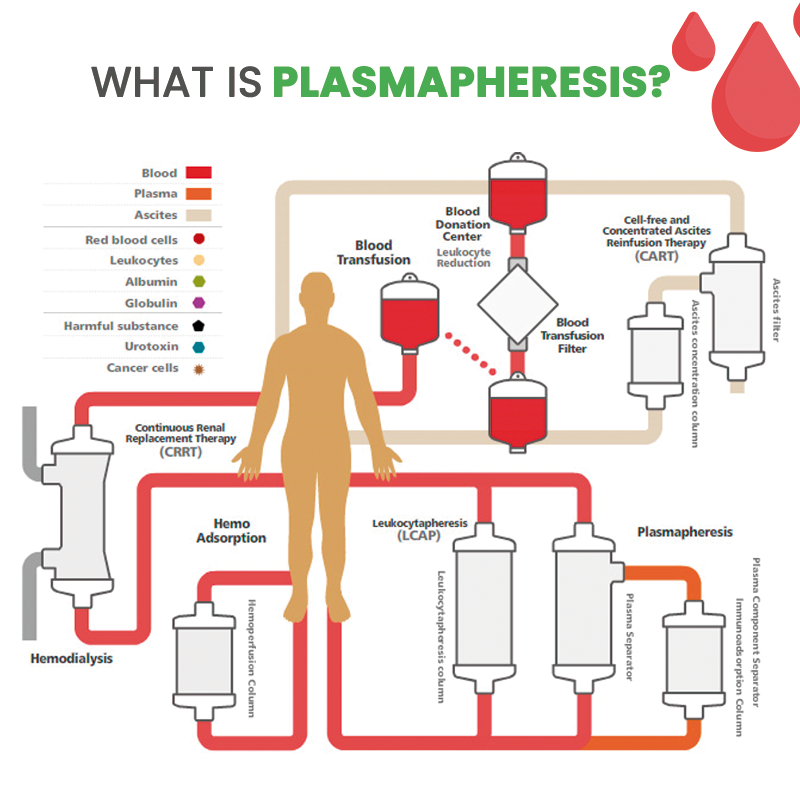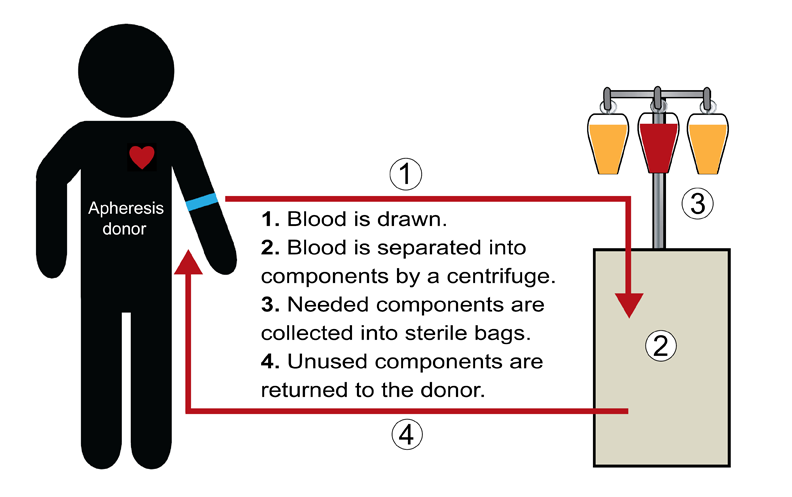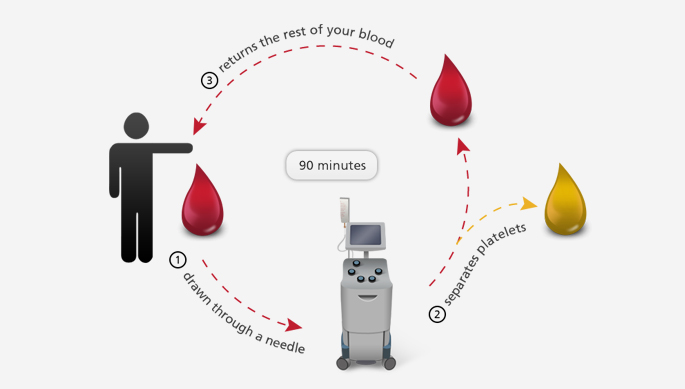What is Apheresis, Apheresis Treatment in Turkey Blood diseases and diseases that require blood have spread over a wide area around the world. For this reason, many people need clean blood treatment. At this stage, apheresis is needed. So, what is Apheresis, and how it is treated, let’s examine it together.
- What Is Apheresis?
- What Are the Types of Apheresis?
- How Is Apheresis Done?
- In Which Diseases Is Apheresis Applied?
- What Does Apheresis Blood Mean?
- Who Is Apheresis Blood Given?
- Advantages of Apheresis
- What Is the Difference Between Apheresis and Whole Blood?
- What Are the Side Effects of Apheresis Donation?
- Apheresis Treatment
- Lipid Apheresis Treatment
- Apheresis Treatment Prices in Turkey
- Is apheresis a platelet?
- What is apheresis vs plasmapheresis?
What Is Apheresis?

Apheresis is the process of taking the blood needed from the donor and separating it into its components. During this process, the blood taken from the patient or the donor is separated into its components with the help of a device. These components are components such as thrombocytes, erythrocytes, and plasma. After taking the components needed by the body, the remaining blood is given back to the donor.
The treatment method is also used for the treatment of stove poisoning, drug poisoning, mushroom poisoning, sudden hearing disturbances, eye diseases, rheumatic diseases, foot injuries caused by diabetes, and even neurological, blood and heart diseases.
What Are the Types of Apheresis?
When looking at what are the types of apheresis, there is more than one type of therapeutic apheresis. We can list them for you as follows:
- Plasmapheresis; In this method, the liquids in the plasma are separated and if the doctor deems it necessary, they are returned to the patient after being separated from certain components by passing through some filters.
- Leukapheresis; In this method, white blood cells are separated.
- Erythrocyte Apheresis; With this method, the red blood cells in the blood are separated.
- photopheresis; In this process, the blood taken from the patient’s body is separated, and after being exposed to light at a certain wavelength, it is separated from unwanted substances.
- Lipid Apheresis; In this type of apheresis, the fats in the blood are separated.
- hemofiltration; In this method, the blood is separated from microscopic substances after passing through a wide variety of filters.
How Is Apheresis Done?
One of the procedures that people who want to be a blood donor are especially afraid of is apheresis. We recommend that you do not forget that there is nothing to be afraid of during this procedure and that you have saved a person’s life by donating blood. So, let’s examine how this Apheresis is done.
- The donor, who will be a blood donor, is taken on a stretcher and relaxed.
- In the apheresis process, two vascular accesses are opened as blood will be taken and given back to the person.
- The blood taken is separated into the desired components by entering the Apheresis machine, these components are removed and the remaining blood is returned to the donor via the other vein.
- The process takes between 1-4 hours depending on the situation.
- If the to be performed is taken from the patient for therapeutic purposes, this procedure is performed regularly, once a week, a few times a week, or once a month, at the time periods to be determined by the doctor.
In Which Diseases Is Apheresis Applied?
It is popularly known as blood purification. During this procedure, the patient or the donor does not feel any pain. The blood taken is separated into its components by passing through apheresis devices, what is needed is taken and the remaining blood is returned to the patient or donor. Well, in which diseases apheresis is applied, Apheresis is applied in the treatment of nearly 100 diseases such as:
- Neurological diseases
- Livers diseases
- Kidneys diseases
- Blood diseases
- Skin diseases
- Infection diseases
- Rheumatic diseases
- Cancers diseases
- Heart diseases
- Cholesterol
- In the treatment of wounds on the feet as a result of diabetes
- In long-term intestinal diseases
- Eyelash
- Sudden hearing problems
- Mushroom poisoning
- Stove poisoning
- Drug poisoning
- Organ transplants
- Stem cell transplants

What Does Apheresis Blood Mean?
If we answer the question of What Apheresis Blood means, it means that the remaining blood is returned to the patient or donor after the blood is taken from the patient or donor, passed through apheresis devices, separated into the desired components, and taken. This process takes approximately 1-4 hours.
Who Is Apheresis Blood Given?
The clearest answer to the question of Who Is Apheresis Blood Given should be to those who need it. Therefore:
- Those with neurological diseases
- For those with liver diseases
- For those with kidney diseases
- For those with blood diseases
- For those with skin diseases
- Those with infectious diseases
- For those with rheumatic diseases
- For those with cancer
- For those with heart diseases
- Those with cholesterol diseases
- In the treatment of wounds on the feet as a result of diabetes
- Those with long-lasting intestinal diseases
- For those with eye diseases
- Those who have sudden hearing diseases
- For those who suffer from mushroom poisoning
- For those who suffer from stove poisoning
- Those who suffer from drug poisoning
- Organ transplant recipients
- For stem cell transplant recipients
and many other diseases are given to people with the approval of the doctor
Advantages of Apheresis
Apheresis is a medical procedure that separates blood components, such as plasma, red blood cells, and platelets. It is used to treat a wide variety of medical conditions, including:
- Blood disorders, such as sickle cell disease, leukemia, and myasthenia gravis
- Autoimmune diseases, such as rheumatoid arthritis and lupus
- Neurological disorders, such as Guillain-Barré syndrome and multiple sclerosis
- Metabolic disorders, such as hypercholesterolemia and familial hyperchylomicronemia
- Poisoning
Apheresis is a relatively safe and effective treatment, but it can have some side effects, such as lightheadedness, bruising, and infection.
Here are some of the advantages of apheresis:
- It can be used to treat a wide variety of medical conditions. Apheresis can be used to remove harmful substances from the blood, collect specific blood components, and replace blood components that are missing or damaged.
- It is a relatively safe and effective procedure. Apheresis is typically performed by a trained healthcare professional in a safe and controlled environment.
- It can be used to collect specific blood components. This is important for patients who need transfusions of specific blood components, such as platelets or plasma.
- It can be used to remove harmful substances from the blood. This can be helpful for patients with conditions such as high cholesterol, autoimmune diseases, and poisoning.
- It can be used to improve the quality of life for patients with chronic medical conditions. Apheresis can help to reduce symptoms, improve function, and prolong life expectancy.
In addition to these general advantages, apheresis also has some specific advantages over other treatments for certain medical conditions. For example, apheresis is more effective than medication at removing cholesterol from the blood in patients with familial hyperchylomicronemia. Apheresis is also more effective than plasma exchange at removing harmful antibodies from the blood in patients with Guillain-Barré syndrome.
Overall, apheresis is a versatile and effective treatment for a wide variety of medical conditions. It is a relatively safe procedure with many advantages over other treatments.
What Is the Difference Between Apheresis and Whole Blood?
What is the difference between apheresis and whole blood?
Apheresis and whole blood are two different ways of collecting blood. Apheresis is a procedure that separates blood components, such as plasma, red blood cells, and platelets. Whole blood is a mixture of all blood components.
Whole blood
Whole blood is collected using a single needle that is inserted into the patient’s vein. The blood is collected into a bag and then transfused to another patient in need.
Whole blood transfusions are typically used for patients who have lost a lot of blood due to trauma or surgery. They can also be used for patients with certain medical conditions, such as anemia or leukemia.
Differences between apheresis and whole-blood
The main difference between apheresis and whole blood is the way the blood is collected. Apheresis separates the blood components, while whole blood is collected as a mixture of all blood components.
Another difference is the amount of blood that is collected. Apheresis typically collects a smaller amount of blood than whole blood transfusions.
Finally, apheresis can be used to treat a variety of medical conditions, while whole blood transfusions are typically used for patients who have lost a lot of blood.

What Are the Side Effects of Apheresis Donation?
Apheresis donation is an important type of donation that saves the lives of many people. It can be seen that people often stay away from this donation if they fear that they will be harmed. Side effects are rare and very few. Even apheresis has many benefits. What are the Side Effects of Apheresis Donation, we can list them for you as follows:
- Numbness around the mouth
- Nausea and accompanying vomiting
- Feeling cold, trembling, and twitching in the muscles
- dizziness condition
- cramping
- Palpitations occur
- Non-serious and often rare side effects such as bruising and swelling in the vein can occur
Apheresis Treatment
Apheresis is a medical procedure that separates blood components, such as plasma, red blood cells, and platelets. It is used to treat a variety of conditions, including:
- Blood disorders, such as sickle cell disease, leukemia, and myasthenia gravis
- Autoimmune diseases, such as rheumatoid arthritis and lupus
- Neurological disorders, such as Guillain-Barré syndrome and multiple sclerosis
- Metabolic disorders, such as hypercholesterolemia and familial hyperchylomicronemia
- Poisoning
Apheresis is a relatively safe and effective treatment, but it can have some side effects, such as lightheadedness, bruising, and infection.
How does apheresis work?
Apheresis is performed using a machine called an apheresis machine. The machine is connected to two needles that are inserted into the patient’s veins. Blood is drawn from one vein and pumped through the machine, which separates the blood components. The desired component is removed or replaced, and the remaining blood components are returned to the patient’s other vein.
What are the different types of apheresis?
There are several different types of apheresis, depending on the condition being treated. The most common types of apheresis include:
- Plasmapheresis: Plasma is the liquid portion of the blood. Plasmapheresis is used to remove harmful substances from the blood, such as antibodies, proteins, and lipids.
- Red blood cell exchange: Red blood cells are responsible for carrying oxygen throughout the body. Red blood cell exchange is used to remove diseased or damaged red blood cells and replace them with healthy cells.
- Plateletpheresis: Platelets are responsible for blood clotting. Plateletpheresis is used to collect platelets from a donor or to remove excess platelets from a patient’s blood.
How often is apheresis needed?
The frequency of apheresis treatments varies depending on the condition being treated. For some conditions, a single treatment may be sufficient. For other conditions, multiple treatments may be needed over a period of weeks or months.
What are the benefits of apheresis?
Apheresis can be a very effective treatment for a variety of conditions. It can help to improve symptoms, reduce the risk of complications, and even save lives.
Apheresis treatment in Turkey
Turkey is a world leader in apheresis treatment. There are many hospitals and clinics in Turkey that offer apheresis services. The quality of care in Turkey is very high, and the cost of apheresis treatment is often much lower than in other countries.
If you are considering apheresis treatment, it is important to talk to your doctor about the risks and benefits of the procedure. Apheresis can be a very effective treatment for a variety of conditions, but it is important to make sure that it is the right treatment for you.
Lipid Apheresis Treatment
Lipid apheresis treatment is a medical procedure that removes harmful lipids, such as cholesterol and triglycerides, from the blood. It is a safe and effective treatment for people with severe hyperlipidemia, or high cholesterol, who cannot control their cholesterol levels with diet and medication alone.
How does lipid apheresis work?
Lipid apheresis is performed using a machine called an apheresis machine. The machine is connected to two needles that are inserted into the patient’s veins. Blood is drawn from one vein and pumped through the machine, which separates the blood components. The lipids are removed, and the remaining blood components are returned to the patient’s other vein.
What are the benefits of lipid apheresis treatment?
Lipid apheresis treatment can significantly reduce cholesterol and triglyceride levels in the blood. This can help to reduce the risk of heart disease, stroke, and other cardiovascular problems. Lipid apheresis treatment can also be used to treat people with familial hypercholesterolemia (FH), a genetic condition that causes high cholesterol levels.
Who is eligible for lipid apheresis treatment?
Lipid apheresis treatment is typically recommended for people with severe hyperlipidemia who cannot control their cholesterol levels with diet and medication alone. This may include people with FH, people with diabetes, and people with a history of heart disease or stroke.
What are the risks and side effects of lipid apheresis treatment?
Lipid apheresis treatment is a relatively safe procedure, but there are some potential risks and side effects, such as:
- Lightheadedness
- Bruising
- Infection
- Allergic reaction
- Bleeding
- Blood clots
How often is lipid apheresis treatment needed?
The frequency of lipid apheresis treatments varies depending on the patient’s individual needs. Some patients may only need a single treatment, while others may need multiple treatments over a period of weeks or months.
Apheresis Treatment Prices in Turkey
Treatment of many diseases is possible within the borders of Turkey. As a result of the devoted work and research of the doctors, the preferences of the citizens abroad are in favor of Turkey.
In the treatment of many diseases, apheresis, popularly known as blood purification, is applied. This process is done by separating the blood taken from the patient or the donor into its components with the help of apheresis devices. After the separation process, the needed blood is taken and the remaining blood is given back to the donor. This procedure can be easily applied in the treatment of almost all diseases that are needed in Turkey.
These applications are carried out in clean, sterile, large, and spacious hospitals by using the latest technological devices. These procedures are performed by specialists and experienced doctors. Treatment fees are also quite affordable.
For these reasons, we can see that patients who come to Turkey for apheresis treatment want to have information about Apheresis Treatment Prices in Turkey in advance. However, since the transactions are personal, it is not very healthy to give clear price information. For this reason, you can contact us to have precise information and price details about apheresis treatment. In addition, if you come to Turkey through us, we can facilitate your visa procedures with the invitation letter we send to the consulate.
Is apheresis a platelet?
Apheresis is a medical procedure that separates blood components, such as plasma, red blood cells, and platelets. It is used to treat a variety of conditions, including blood disorders, autoimmune diseases, neurological disorders, and metabolic disorders.
Platelets are a type of blood cell that helps the blood to clot. Plateletpheresis is a type of apheresis that collects platelets from a donor. The platelets can then be used to treat patients who have low platelet counts or who need platelet transfusions.
What is apheresis vs plasmapheresis?
Apheresis and plasmapheresis are two medical procedures that involve separating blood components. Apheresis is a more general term that can refer to the collection of any type of blood component, such as plasma, red blood cells, or platelets. Plasmapheresis is a specific type of apheresis that focuses on the collection of plasma.

Vimfay International Health Services